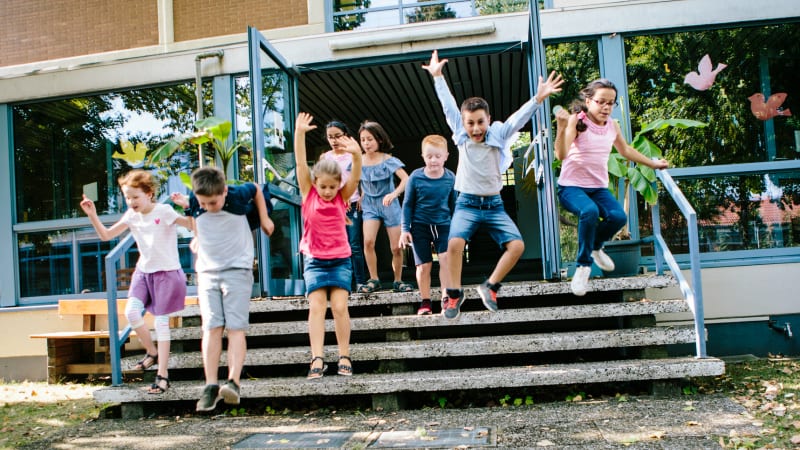Kids need recess. We all know this—studies and reports, like this one from the American Academy of Pediatrics, tell us about its countless cognitive, social, emotional, and physical benefits. Yet, a Gallup study showed that 77 percent of school principals reported taking away recess as a punishment.
So let’s talk alternatives. We asked school leaders across the country to share their ideas on our Principal Life Facebook page. Here are some of the best responses.
1. Create a room for kids to reflect.
Martha writes, “For minor behaviors, we have an early intervention room (EIR). There, students are required to fill out a think sheet about their behavior and how they can do better.”
Another way to use a room like this is make it a place for lunchtime detention—another tip from Martha. This way, students can go and eat their lunch in this place of reflection, but it won’t interfere with their recess.
2. Don’t be afraid to immediately change your system.
You don’t have to wait until next August to talk about a new classroom-management system or discipline strategy. If what you have isn’t working, then it’s time to reevaluate. Mary writes, “We check our protocols and management systems all the time to see if they need to be improved.”
She says that if the same behavior keeps surfacing, then it might be time for a new approach. Try positive reinforcement. Create a classroom or school-wide goal. Ask for new ideas to try at a staff meeting.
3. Have students practice good behavior again, and again, and again.
Mary also wrote to us about how important it is to practice good behavior, especially at the beginning of the school year, with things like morning meetings, circles, creating a classroom constitution, etc.
Yet there will always be times during the year when it feels like it’s utter chaos and the rules aren’t being observed. In times like this, it’s important to go back to the basics. Pull out those rules and charts that you had at the beginning of the year. Set new expectations as if you’re explaining the rules for the first time. Sometimes students (and staff) just need a reset to get through.
4. Require students to come up with answers.
Principals told us time and time again that you have to let students be involved in acknowledging their behavior and coming up with alternative solutions. Whether you use a think sheet or have a teacher talk it out with them one on one, it’s important that they help come up with solutions.
5. Use restorative practices, like the WITS strategy.
Several principals talked about using the WITS strategy:
- Walk away.
- Ignore.
- Talk it out.
- Seek adult support.
Try using this with students—and be relentless with it. If you have a student who is repeatedly challenging you or teachers with their behavior, then take them aside each and every time to go over WITS. It might seem like a waste at first, but it will eventually start to sink in. You can also learn more about restorative justice here.
6. Try having an alternative recess.
Some principals talk about having an alternative recess where they gather students who are having some issues and then staff do strategic games with them. “They’re getting social lessons as well as their playtime. Generally we don’t have to do it longer than a week before they figure it out,” T.S. writes.
7. Monitor recess time more closely.
Here’s an idea that a principal recommended using when you’re dealing with a more extreme case. If you have a student who still needs to be watched closely, yet you don’t want to take recess away, then assign someone to keep an eye on them. This way, if the misbehavior continues, there’s someone right there to offer consequences. Maybe consequences include losing rights to certain equipment or areas of the playground.
8. Assign reflection tasks (not detention) to students outside of recess time.
Detention doesn’t do much in the way of reflection, so instead try assigning reflection tasks. These tasks are often jobs around the school, including cleaning, picking up garbage outside, etc. Principals say this is a good solution because it offers quiet time to reflect while also benefiting the school.
Be sure the student knows why they are there and the expectations for future behavior. That way, it’s truly intended to be reflective. If needed, assign this time before or after school so they don’t miss class time.
9. Be creative but also make the consequences fitting.
Monet writes that she wants the consequences to fit the offense at hand. She admits that she often has to get creative, but addressing behavior issues individually has been more effective at her school overall.
“For example, a student throwing trash out the bus window spends an hour picking up trash on school grounds. Or, a student constantly using profanity has to take sandpaper and rub a block of wood I’ve written the word on until it disappears. I’ve asked parents to come in and sit right beside their child for the entire day if the student is a constant disruption. Students have written apology letters to their classmates and read them out loud to the entire class. I always run my ideas by parents to get their support before doing anything. Nine times out of 10, they tell me to go for it.”
10. Try a peer-to-peer approach.
Kristen writes that she never takes recess away because she knows students need the time to play, decompress, and practice socialization in an unstructured setting. Instead, they try using positive reinforcement by pairing kids together.
“Kids that struggle in school are paired up with somebody for a check-in/check-out program. If it’s a severe infraction, we meet with the family to make a behavior plan. Each kid is different and requires a different approach and/or plan.”
Do you have ideas for discipline and accountability that don’t involve taking away recess? Share with us in our Principal Life Facebook group .
Plus, check out these TED Talks to inspire educators.

